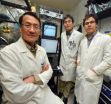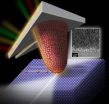(Press-News.org) New research has shown that a protein, known as IL-13, could be the key to the development of fibrosis in Crohn's disease. This breakthrough could help to advance new medicines to treat people suffering with the disease.
Crohn's disease is a chronic, debilitating condition characterised by inflammation and ulceration occurring at any point in the gastrointestinal tract. Currently there is no cure. One of the major complications of Crohn's disease is the development of fibrosis – hardening and thickening – in the bowel wall. This causes the intestine to lose its mobility and it eventually becomes so narrow that food and faeces are unable to pass.
Fibrosis occurs when there is an overproduction of the proteins which are normally involved in the tissue healing process, including collagens.
The research team, led by the School of Veterinary Sciences at the University of Bristol, found an increase in collagen synthesis and a lack of control of collagen deposition in fibrotic intestine taken from Crohn's disease patients when compared to normal intestine. The researchers believe that this is related to an increase in a soluble mediator, interleukin 13 (IL-13), previously identified as promoting fibrosis in the lung, liver and kidney.
Increased levels of IL-13 were found in fibrotic Crohn's gut when compared to normal gut, and tissue culture experiments showed that IL-13 reduced factors necessary to prevent inappropriate collagen deposition.
Dr Jenny Bailey, a researcher in the School of Veterinary Sciences at the University of Bristol, said: "We have identified a novel population of IL-13-producing cells which, in intestinal samples, were found at very high levels in fibrotic muscle. We believe these cells are key to the development of fibrosis.
"Understanding how fibrosis occurs will help us to develop new medicines to treat patients."
Since many patients developing fibrosis will require surgery, early intervention strategies may prevent severe morbidity, to which end IL-13 and IL-13-producing cells provide a promising therapeutic target.
Although there is some success in treating the inflammation in Crohn's disease, there are no current effective drugs to treat fibrosis. In cases of severe fibrosis, the only remedy is surgical excision of the strictured gut and around 30 per cent of Crohn's disease sufferers will undergo surgery at least once. Unfortunately, removal of the fibrotic tissue does not prevent fibrosis recurring in another part of the intestine and Crohn's patients frequently have to endure repeated surgery, eventually resulting in a short bowel which is no longer able to sustain adequate function.
###The study, published in PLoS ONE, was carried out in the laboratories of Dr John Tarlton and Dr Christine Whiting at the University of Bristol's School of Veterinary Sciences, in collaboration with Dr Paul Bland at the University of Gothenburg and Professor Chris Probert at the University of Liverpool. Work to further explore these important findings is on-going.
The work was funded by Action Medical Research, National Association for Colitis and Crohn's Disease, Swedish Fund for Strategic Research and Edith Lidiard Bequest.
Paper: IL-13 Promotes Collagen Accumulation in Crohn's Disease Fibrosis by Down-Regulation of Fibroblast MMP Synthesis: A Role for Innate Lymphoid Cells?, Bailey JR, Bland PW, Tarlton JF, Peters I, Moorghen M, et al., PLoS ONE, 31 December 2012.
How does fibrosis occur in Crohn's disease?
2013-01-30
ELSE PRESS RELEASES FROM THIS DATE:
Academic gains, improved teacher relationships found among high risk kids in Head Start
2013-01-30
BEND, Ore. – A new study by Oregon State University researchers finds that Head Start can make a positive impact in the lives of some of its highest risk children, both academically and behaviorally.
Published in the current issue of the Journal of Applied Developmental Psychology, the study sheds light on how Head Start has helped children living in non-parental care, or living with someone who is not a parent or step-parent by biology or adoption.
"These children tend to have unstable home lives, sometimes transitioning between different relatives, living with their ...
Snails signal a humid Mediterranean
2013-01-30
An international team of researchers has shown that old wives' tales that snails can tell us about the weather should not be dismissed too hastily.
While the story goes that if a snail climbs a plant or post, rain is coming, research led by the University of York goes one better: it shows snails can provide a wealth of information about the prevailing weather conditions thousands of years ago.
The researchers, including scientists from the Scottish Universities Environmental Research Centre (SUERC), analysed the chemistry of snail shells dating back 9,000 to 2,500 years ...
Scientists learn more about how inhibitory brain cells get excited
2013-01-30
AUGUSTA, Ga. – Scientists have found an early step in how the brain's inhibitory cells get excited.
A natural balance of excitement and inhibition keeps the brain from firing electrical impulses randomly and excessively, resulting in problems such as schizophrenia and seizures. However excitement is required to put on the brakes.
"When the inhibitory neuron is excited, its job is to suppress whatever activity it touches," said Dr. Lin Mei, Director of the Institute of Molecular Medicine and Genetics at the Medical College of Georgia at Georgia Regents University ...
A new genre of 'intelligent' micro- and nanomotors
2013-01-30
Enzymes, workhorse molecules of life that underpin almost every biological process, may have a new role as "intelligent" micro- and nanomotors with applications in medicine, engineering and other fields. That's the topic of a report in the Journal of the American Chemical Society, showing that single molecules of common enzymes can generate enough force to cause movement in specific directions.
Peter J. Butler, Ayusman Sen and colleagues point out that enzymes — proteins that jump-start chemical reactions — are the basis of natural biological motors essential to life. ...
Penn research shows mechanism behind wear at the atomic scale
2013-01-30
PHILADELPHIA — Wear is a fact of life. As surfaces rub against one another, they break down and lose their original shape. With less material to start with and functionality that often depends critically on shape and surface structure, wear affects nanoscale objects more strongly than it does their macroscale counterparts.
Worse, the mechanisms behind wear processes are better understood for things like car engines than nanotech devices. But now, researchers at the University of Pennsylvania's School of Engineering and Applied Science have experimentally demonstrated ...
Researchers improve medical units to reduce nursing fatigue, cut costs
2013-01-30
ITHACA, N.Y. – In hospitals, poor floor design, storage closet clutter and crowded corridors can contribute to nurse and medical staff fatigue. These distractions can hurt patient care quality and result in higher medical costs.
Now, a new Cornell University study offers a spatial solution.
Rana Zadeh, Cornell assistant professor of design and environmental analysis in the College of Human Ecology, analyzed the floor plans and work patterns within five medical-surgical units at U.S. hospitals and found numerous opportunities to boost nurses' efficiency through better ...
Conflicting cultural identities may foster political radicalism
2013-01-30
New research suggests that dual-identity immigrants — first-generation immigrants and their descendants who identify with both their cultural minority group and the society they now live in — may be more prone to political radicalism if they perceive their two cultural identities to be incompatible.
The new research is published in Psychological Science, a journal of the Association for Psychological Science.
Psychological scientist Bernd Simon from Kiel University in Germany and colleagues hypothesized that perceived incompatibility between the two cultural identities ...
Aging cells lose their grip on DNA rogues
2013-01-30
PROVIDENCE, R.I. [Brown University] — Even in our DNA there is no refuge from rogues that prey on the elderly. Parasitic strands of genetic material called transposable elements — transposons — lurk in our chromosomes, poised to wreak genomic havoc. Cells have evolved ways to defend themselves, but in a new study, Brown University researchers describe how cells lose this ability as they age, possibly resulting in a decline in their function and health.
Barbara McClintock, awarded the Nobel Prize in 1983, made the original discovery of transposons in maize. Since then ...
GEOLOGY starts 2013 with 25 new articles posted online ahead of print
2013-01-30
Boulder, Colo., USA - Geology content posted online 4 through 25 January 2013 cover topics from greenhouse gas emissions to video observations of erupting geysers in Russia and from the age of Earth to the age of Grand Canyon. Highlights and detailed information about each article are listed below.
1. Earth is mostly flat
2. Age maps of early Earth
3. Sagaing fault, Indo-Burmese wedge
4. Anthropogenic lead
5. The growth of a newly born submarine volcano
6. The Hemlo gold deposit, Ontario, Canada
7. Reptile and mammal fossils in the Karoo Basin, South Africa
8. ...
U. of Minn. researchers unveil first artificial enzyme created by evolution in a test tube
2013-01-30
There's a wobbly new biochemical structure in Burckhard Seelig's lab at the University of Minnesota that may resemble what enzymes looked like billions of years ago, when life on earth began to evolve – long before they became ingredients for new and improved products, from detergents to foods and fuels.
Seelig created the fledgling enzyme by using directed evolution in the laboratory. Working with colleague Gianluigi Veglia, graduate student Fa-An Chao, and other team members, he subsequently determined its structure, which made its debut December 9 as an advance online ...





